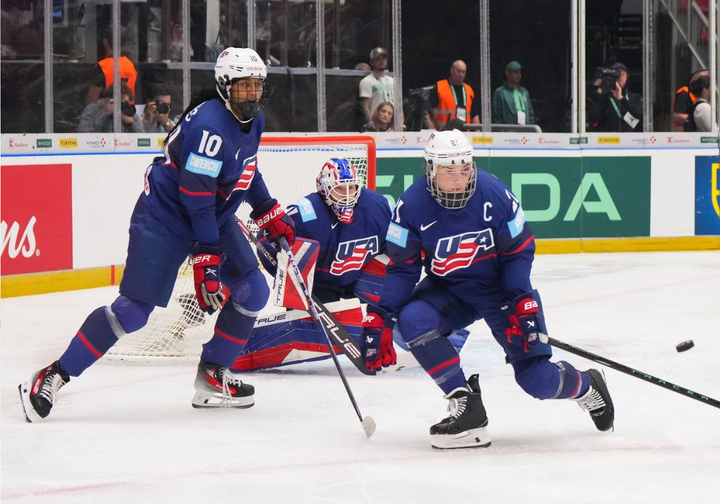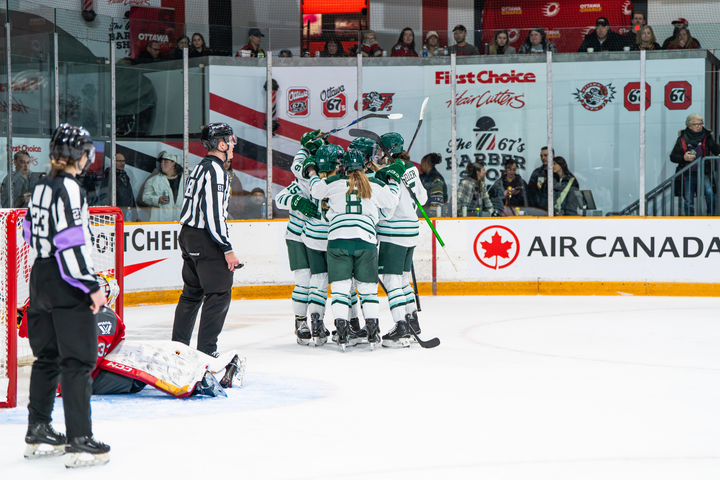TIG Roundtable: Our thoughts on the NWHL bubble
Our writers sat down to share their thoughts about the latest in NWHL news.
Last week the NWHL announced they plan to play a shortened 2020-21 season in a bubble in Lake Placid amid the COVID-19 pandemic. The league’s sixth season will be two weeks long, including the regular season and the playoffs. They’ll follow in the footsteps of successful bubbles by the NWSL, the WNBA, the NBA, and the NHL.
A few writers at TIG gathered around their computers - at various times and in their various homes - to react to the NWHL’s bubble plans.
Related
NWHL plans to play 20-21 season in a bubble
Mike Murphy: I am not an infectious disease expert — not yet, anyway — but there is definitely a lot to like about the NWHL’s plan at first glance. Just last week I spoke with Melissa Burgess of the Victory Press about the potential of a bubble on a podcast and expressed a great deal of skepticism because it seemed like a logistical nightmare. To be honest, it still feels like a logistical nightmare, but this plan could work. And that is huge.
Something we all need to keep in mind is that this plan is likely a first draft of what we may or may not see in late January and early February. A lot can change over the next few months. What happens if COVID-19’s numbers explode around Lake Placid? How will housing work? What happens if a player contracts COVID while in the league’s bubble? Like I said, a lot can change.
The good news is that there’s cause to be optimistic. The fact that players can opt-out and still get paid their full salary is a tremendous victory for the NWHLPA. The other big victory here is that 95 percent of the players who are signed are committed to the bubble. The players are on board. That means they have faith in the league executing this safely and responsibly.
Anne Tokarski: To be honest, when the NWSL and WNBA first announced their bubbles, my first thought was, “How can we make this work with women’s hockey?” There was the obvious caveat that most professional women’s hockey players have day jobs, but given the possibility and popularity of remote work, I’m more optimistic now than I was before the idea of a women’s hockey bubble even became a reality. I’m still not entirely sold on the intricacies of testing or how the league will be able to pull off the bubble, but I’m hopeful that as the start date nears, we’ll get more information and complete transparency regarding testing, isolation, etc.
I feel a lot better about the NWHL season than I do about the college hockey season, to be entirely honest. Partly because the NWHL will be playing in a bubble, and partly because even the youngest, the twenty-two and twenty-three year old rookies, are a lot less likely to go to a party or a super-spreader event than a nineteen year old on a college campus.
While my thoughts were kind of all over the place, my TL;DR is this: I think this is the best option for the NWHL for this season. A full slate of games, outside of a bubble, with travel between two countries, is just not safe or feasible at this point and I wouldn’t feel good or excited when there are so many athletes, coaches, support staff, and community members at risk.
Casey Bryant: This is a win. Those who view it as anything less need to consider the alternatives, namely: 1) relying on local and state governments and health departments in five different American states to allow interstate travel for multiple months; 2) those interstate rules get even more complicated when overnight stays are involved, which would have to be the case for any Whitecaps game; 3) the whole Canada Thing for the Six; 4) even if travel is open for all five states and the Six found somewhere to play temporarily in the US, they would more than likely limit capacity if they allowed any fans at all, which would kill the league’s bottom line when it comes to ice time costs and travel expenses.
A shortened round-robin tournament leading into a four-seed playoff is perfectly serviceable. In fact, it’s actually quite dramatic. This is the first time in league history that any team can be eliminated from Isobel Cup Playoff contention, which gives seeding an importance it really never has had before. It’s thrilling, really.
Not to mention the venue. Herb Brooks Arena is crawling with Hockey Ghosts. It’s very similar to Cooperstown, NY, where seemingly the entire local economy has been built around one specific thing. That specific thing happens to be hockey in Lake Placid. Fans or no fans, the NWHL has an exciting opportunity on their hands to deliver a quality product.
Leighann Strollo: To be completely honest, my initial reaction was to be disappointed. It took about five seconds for me to remember we were in fact still in the middle of a pandemic and that I logically agree with everything Casey said above me, but I have just felt so starved from NWHL hockey, that knowing we aren’t getting a full season made me sad.
That being said, this is one of the coolest places to do bubble hockey and I know it’s going to be a fantastic time in a world where there’s so much uncertainty at the moment. My biggest concern or unanswered question headed into this season, considering COVID, was going to be how traveling works across borders. I was certain, even months ago that it would complicate play with Toronto and an obvious solution to that is having a bubble season.
The way it was announced was perfect, in my opinion too. The league waited until they had 95 percent of players signed on to play bubble hockey before announcing it which says to me that they put in a lot of work to make sure none of the players with day jobs that are hard to leave for two weeks were put in a bad position. Additionally, the most important thing announced was that all players will receive full compensation for a full season. That’s big and tells me that the NWHL isn’t struggling financially as many liked to claim.
Now the most important thing we need to figure out is, obviously, what are we calling the NWHL bubble?!
Angelica Rodriguez: There’s a lot of “wait and see” when it comes to my opinion on the NWHL bubble. What we’re getting right now is of course an ideal version of what we might get in late January, but the variables surrounding this virus and this plan are such that who knows what will truly happen by the time players are scheduled to arrive.
With that said, I think the plan itself is a solid one. Obviously, we all want hockey to be back for longer than a couple of weeks, but I think this is a good example of making do with what we’ve got. Keeping all the players in one central location, in a state with some of the strictest testing and travel regulations surrounding COVID-19 and in such an idyllic location, is about as good as it will get, especially for a fledgling, six-year-old league.
As others in this roundtable have already addressed, there are still plenty of questions surrounding how players will be accommodated in Lake Placid, how testing will work, and of course, how level of play and especially mental and physical effects on players will be different. Consider that we’re going to be getting a LOT of women’s hockey in two weeks, compounded by the fact that one game can seal the deal or send a team packing. The stakes will be higher than ever, meaning we could be in for some incredible games and even a brand new Isobel Cup champion (after all, we’ve seen what the Whale did late last season and what the Beauts did in 2017). Of course, that could also lead to a sort of expectations-vs-reality situation when it comes to testing and transparency surrounding it, something I truly hope wouldn’t happen but is possible with any competitive league where there’s plenty at stake if a big time player has to bow out.
There’s also a question of streaming or possibly television deals — for example, would one of the sports networks trumpeting this announcement a few days ago actually take a chance and air some games? How will Twitch factor in for a bubble season? What are NWHL’s social media handlers’ plans for keeping fans and reporters up-to-date and engaged in an atmosphere where we’ll all (media potentially included) likely be confined to our computer screens? And for that matter, what does this do for revenue for the NWHL if and when you have games with no fans actually in attendance? All of this I’m hoping will be addressed in the two months between now and then, and thus... well, the jury is still out for me.





Comments ()